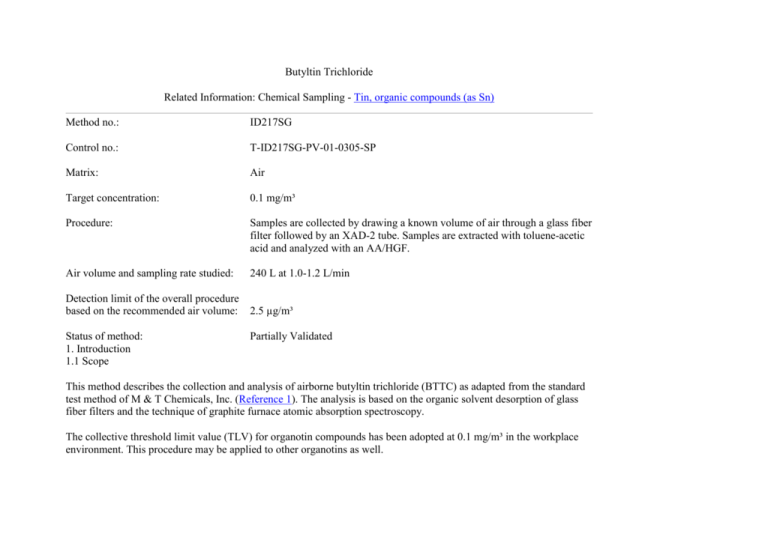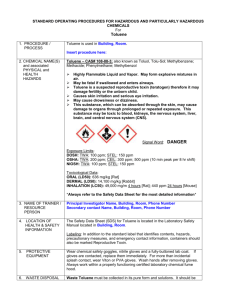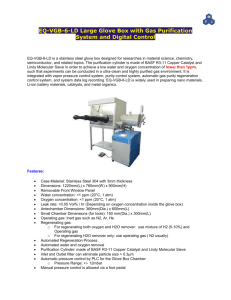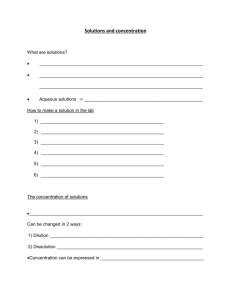Butyltin Trichloride Related Information: Chemical Sampling
advertisement

Butyltin Trichloride Related Information: Chemical Sampling - Tin, organic compounds (as Sn) Method no.: ID217SG Control no.: T-ID217SG-PV-01-0305-SP Matrix: Air Target concentration: 0.1 mg/m³ Procedure: Samples are collected by drawing a known volume of air through a glass fiber filter followed by an XAD-2 tube. Samples are extracted with toluene-acetic acid and analyzed with an AA/HGF. Air volume and sampling rate studied: 240 L at 1.0-1.2 L/min Detection limit of the overall procedure based on the recommended air volume: 2.5 µg/m³ Status of method: 1. Introduction 1.1 Scope Partially Validated This method describes the collection and analysis of airborne butyltin trichloride (BTTC) as adapted from the standard test method of M & T Chemicals, Inc. (Reference 1). The analysis is based on the organic solvent desorption of glass fiber filters and the technique of graphite furnace atomic absorption spectroscopy. The collective threshold limit value (TLV) for organotin compounds has been adopted at 0.1 mg/m³ in the workplace environment. This procedure may be applied to other organotins as well. 1.2 History and Background Historically, manufacturers have used SnCl2 in sensitizing glass and plastic before metalizing. However, they have currently been using butyltin trichloride for that purpose. The particulate matter is collected from air on a glass fiber filter, followed in line by an XAD-2 tube containing a synthetic amberlite resin. The entire GFF and backup pad are removed from the cassette and extracted with tolueneacetic acid. Aliquots of both the GFF extract and the XAD extract are introduced into the graphite furnace and the absorbance is read at 286.4nm. 1.3 Uses Butyltin trichloride is used as a manufacturing intermediate, a catalyst, and a stabilizer (Reference 2). 1.4 Physical and Chemical Properties Appearance : Colorless to yellow liquid Sp. Gr. : 1.17 (25/4°C) B.P. : 101°C (12-mm) % Sn : 42.1% (check stock analysis Mol. Wt. : 282 2. Range and Detection Limit 2.1 The lower analytical limit for butyltin trichloride is 0.1 µg/L. 2.2 This is based on a detection of 0.02 µg/mL for a graphite furnace analysis of BTTC as Sn in toluene-acetic acid. 3. Precision and Accuracy Six glass fiber filters were spiked with l0 µL of 2880 ppm BTTC in toluene based on a 1/2 day air volume of 240 L and the OSHA standard of 0.1 mg/m³. For these six samples the average recovery was 1.043, the standard deviation was 0.692, and the coefficient of variation was 0.023. 4. Interferences Other organotin compounds will interfere if they are soluble in toluene-acetic acid. Inorganic tin compounds are to be considered a potential interference if they are not separated using the tropolone-toluene procedure. 5. Sampling Procedure The sample is collected on a glass fiber filter in series with an XAD-2 tube at a flow rate of 1.0 to 1.5 L/min and a recommended air volume of 250 L. The sample cassettes and tubes are plugged, sealed with OSHA Form 21, and sent to the laboratory for analysis as soon as possible. 6. Analytical Procedure 6.1 Apparatus 6.1.1 Sample Collection Personal sampling pumps Glass fiber filter sampling cassettes with backup pads XAD-2 tubes 6.1.2 Sample Analysis Laboratory Glassware to include volumetric flasks, 50-mL screw cap tubes, assorted pipets. Atomic absorption spectrophotometer with graphite furnace and electrodeless discharge lamp for tin. 6.2. Reagents All reagents should be ACS analyzed reagent grade or better 6.2.1 Glacial Acetic Acid 6.2.2 Toluene 6.2.3 Stock Butyltin Trichloride 6.3 Safety Precautions (Reference 3) 6.3.1 Use caution when handling all organotin compounds, toluene, and the glacial acetic acid. Butyltin trichloride is a harmful liquid, readily absorbed through the skin, corrosive, and combustible. Glacial acetic acid will cause severe burns, is harmful if inhaled, and is combustible with a flashpoint of 103°F. Toluene is a flammable liquid and its vapors should not be inhaled. Waste organics should be collected in a suitable marked container and properly disposed. Always use rubber gloves and work in a fume hood. Observe warning labels on reagent bottles. 6.3.2 Avoid using glassware with chips, stars, or sharp edges. Never pipet any of these materials by mouth. 6.3.3 Before using the graphite furnace, the analyst should read the operator's manual and be familiar with the equipment. Ensure that the furnace tube is properly seated, the contact rings are clean, the cooling water is circulating sufficiently, and that the argon pressure will be constant for the entire analysis. Always wear safety glasses and never look at the tube during atomization. Even during normal firing, the intense light is harmful to the eyes. Be aware of the high current supplied to the furnace through the copper cables; check that the insulating cover is in place over the terminals. Since toxic substances are vented by the furnace, a fume hood must be in operation over the furnace. 6.3.4 Observe care with respect to harming the equipment. Do not operate an EDL below its recommended wattage. Be certain that the purge air is circulating when using the background corrector. Do not operate any of the equipment without first reading its instruction manual. 6.4 Glassware Preparation 6.4.1 All glassware must be scrupulously cleaned with concentrated HCl by soaking for several hours or overnight and then rinsing several times with deionized water. Cleaning time for sample glassware may he shortened to rinsing with concd. HCL, DI water, and then finally with toluene. 6.5 Standard Preparation 6.5.1 The procedure is to analyze the tin in butyltin trichloride. Prepare the standards by dissolving 0.04751 grams of BTTC neat liquid in 40 mL glacial acetic acid and dilute to 200 mL volume. This will be a 100 ppm stock solution as Sn, assuming a theoretical tin content of 42.1%. 6.5.2 Prepare an intermediate stock solution (10 ppm as Sn) by diluting 10 mL of the 100 ppm stock to volume with glacial acetic acid in a 100 mL volumetric flask. 6.5.3 Prepare four working standards from the 10 ppm intermediate stock as follows: Std Prepared Std Soln Used Aliquot Dil Vol 1.0 ppm 0.5 ppm 0.1 ppm 0.05 ppm 10.0 ppm 1.0 ppm 1.0 ppm 0.5 ppm 10 mL 25 mL 5 mL 5 mL 100 mL 50 mL 50 mL 50 mL The 1.0 ppm working standard is diluted to volume with toluene and the other three working working standards are diluted to volume using 10% glacial acetic acid in toluene. 6.6 Sample Preparation Transfer the glass fiber filter and XAD-2 tube sections A and B to separate screw cap tubes. 6.6.2 Pipet 5 mL of glacial acetic acid into each screw cap tube, shake for 5 minutes, and let stand for one hour. 6.6.3 Pipet 25 mL of toluene into each screw cap tube and then shake for 30 minutes. 6.6.4 if subsequent dilutions are necessary, use the toluene-acetic acid solution. 6.7 Analysis The analysis is done by graphite furnace atomic absorption spectrophotometry. Instrument parameters for determining tin in toluene-acetic acid are as follows: Atomic absorption spectrophotometer parameters Sn wavelength 286.4nm Integration time Slit width Mode BGC 10 sec .7 low Absorbance on Graphite furnace parameters Step dry char atomize Temperature 100°C 800°C 2500°C 6.7.1 Chart Settings Ramp Time Hold Time 30 sec 30 sec 0 sec 10 sec 10 sec 8 sec Internal Flow 30 mL/min 30 mL/min 0 mL/min Range 10 = mV full scale Chart = 20 mm/min 6.7.2 Parameters are adjusted so that the 1.0 ppm working standard gives near full-scale deflection on the chart. All calibration standards are run at the beginning and end of the analysis; a standard is also run after every five samples during the analysis. 6.8 Calculations 6.8.1 Either the OSHA Auto-AA program or the Auto-Colorimetric program is used for the calculations. 6.8.2 Results are reported as mg/m³ Sn based on the total micrograms of organotin (as Sn) and the air volume. 7. Recovery Study A recovery study of BTTC from glass fiber filters and XAD-2 tubes was done by desorption in toluene-acetic acid. One milliliter of BTTC was measured into a 250 mL volumetric flask, diluted to volume with toluene, and mixed. Assuming the BTTC is 42.1% tin, this is equivalent to 2860 ppm BTTC (as Sn). Six glass fiber filters were spiked with 10 µL of the 2860 PPM BTTC (or 28.8 µg). The spiked filters were air dried on a large white test tube rack and placed on a backup pad in a plastic cassette. Each cassette was attached to a Dupont P-4000 air sampling pump with an XAD-2 tube in line behind the filter cassette. A seventh cassette, tube, and pump were set up to be used as an air blank. Between 200 and 300 liters of air was drawn through the filters and XAD tubes, after which the filters and tubes were removed, placed into separate 50 mL screw cap tubes, and desorbed with toluene-acetic acid according to the procedure described in Section 6.6 for sample preparation. The samples were then analyzes by graphite furnace and the statistical data are shown as follows: BTTC Recovery Study Results GF-1 + BP GF-2 + BP GF-3 + BP GF-4 + BP GF-5 + BP GF-6 + BP = = = = = = 20.14 + 9.02 21.36 + 8.29 20.78 +10.34 21.75 + 8.80 20.46 + 9.64 21.49 + 8.29 AVE. Average Recovery Standard Deviation Coefficient of Variation = = = = = = = 29.2 29.6 31.1 30.6 30.1 29.8 30.1 = 1.043 = 0.62 = 0.023 For this recovery study, there was no BTTC detected in any of the XAD-2 tubes and the backup pads were analyzed separately. In future work the backup pads and glass fiber filters may be desorbed in the same screw cap tube (i.e., analyzed together). 8. References 1. "Determination of Butyl Organotin Compounds in Air Samples by AAS-Graphite Furnace", Standard Test Methods, Method No. AA-62, M&T Chemicals, Inc., June 6, 1984. 2. G.G. Hauley, Condensed Chemical Dictionary, 9th Edition, p. 142, 1977. 3. Bis(Tributyltin) Oxide, OSHA Laboratory Method, Method No.ID-102-SG, Unpublished, 1984.





